Critical Appraisal of a Research Study on Lived Seclusion Experience of Patients in Acute Psychiatric Hospital
VerifiedAdded on 2023/03/30
|11
|2477
|415
AI Summary
This essay critically appraises a research study on the lived seclusion experience of patients in an acute psychiatric hospital. It examines the methodology, findings, and implications for practice. The study aims to understand the perception of patients towards seclusion and provides recommendations for improving patient experience in psychiatric care.
Contribute Materials
Your contribution can guide someone’s learning journey. Share your
documents today.
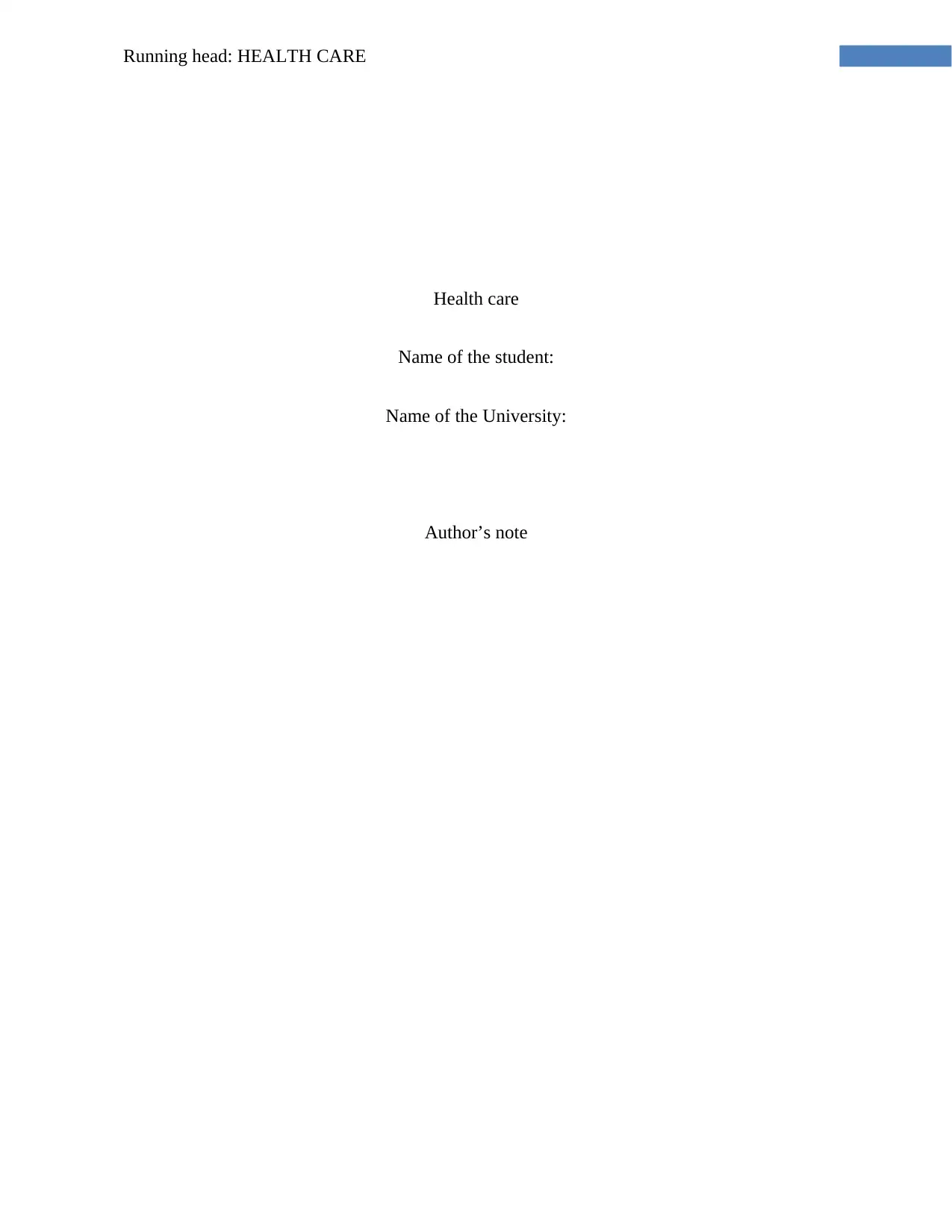
Running head: HEALTH CARE
Health care
Name of the student:
Name of the University:
Author’s note
Health care
Name of the student:
Name of the University:
Author’s note
Secure Best Marks with AI Grader
Need help grading? Try our AI Grader for instant feedback on your assignments.
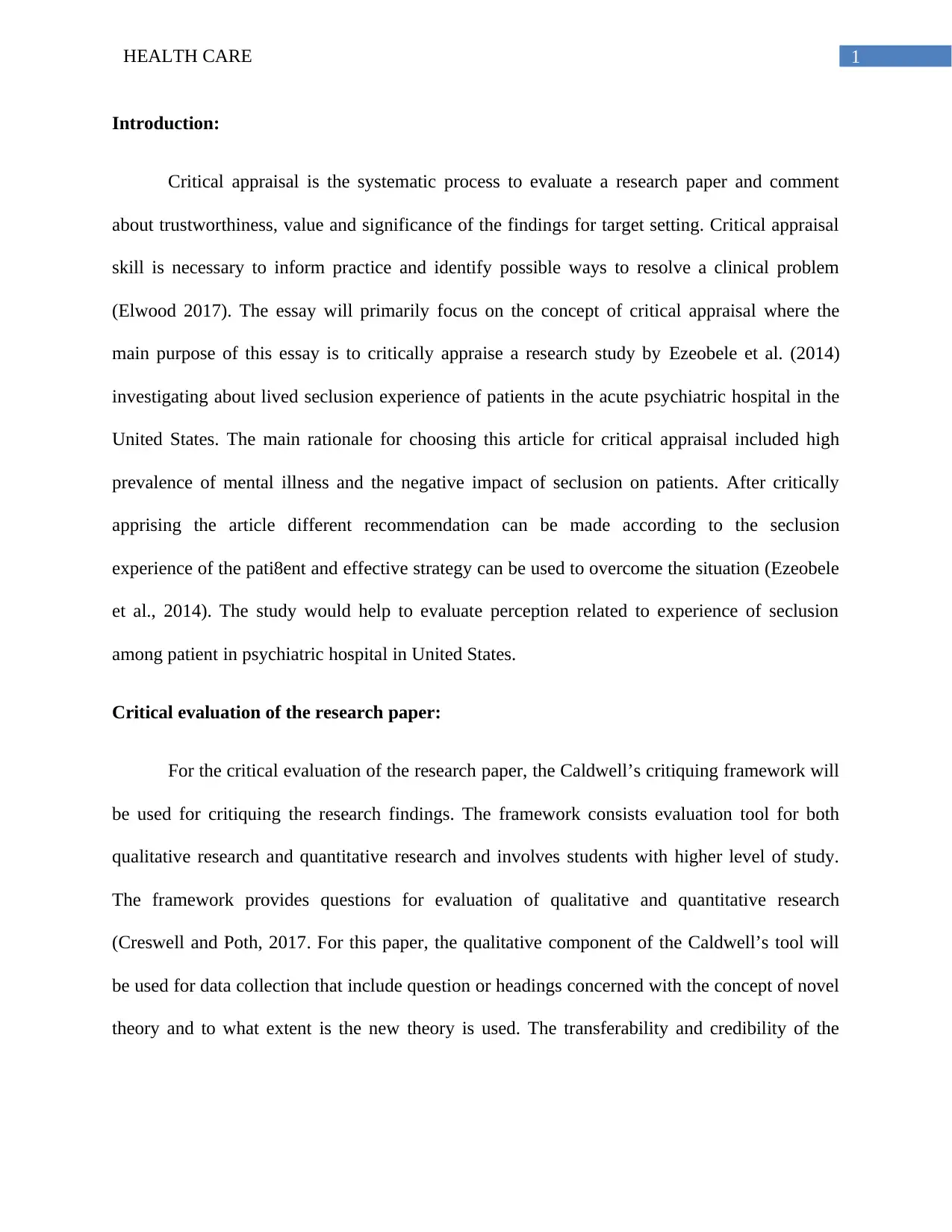
1HEALTH CARE
Introduction:
Critical appraisal is the systematic process to evaluate a research paper and comment
about trustworthiness, value and significance of the findings for target setting. Critical appraisal
skill is necessary to inform practice and identify possible ways to resolve a clinical problem
(Elwood 2017). The essay will primarily focus on the concept of critical appraisal where the
main purpose of this essay is to critically appraise a research study by Ezeobele et al. (2014)
investigating about lived seclusion experience of patients in the acute psychiatric hospital in the
United States. The main rationale for choosing this article for critical appraisal included high
prevalence of mental illness and the negative impact of seclusion on patients. After critically
apprising the article different recommendation can be made according to the seclusion
experience of the pati8ent and effective strategy can be used to overcome the situation (Ezeobele
et al., 2014). The study would help to evaluate perception related to experience of seclusion
among patient in psychiatric hospital in United States.
Critical evaluation of the research paper:
For the critical evaluation of the research paper, the Caldwell’s critiquing framework will
be used for critiquing the research findings. The framework consists evaluation tool for both
qualitative research and quantitative research and involves students with higher level of study.
The framework provides questions for evaluation of qualitative and quantitative research
(Creswell and Poth, 2017. For this paper, the qualitative component of the Caldwell’s tool will
be used for data collection that include question or headings concerned with the concept of novel
theory and to what extent is the new theory is used. The transferability and credibility of the
Introduction:
Critical appraisal is the systematic process to evaluate a research paper and comment
about trustworthiness, value and significance of the findings for target setting. Critical appraisal
skill is necessary to inform practice and identify possible ways to resolve a clinical problem
(Elwood 2017). The essay will primarily focus on the concept of critical appraisal where the
main purpose of this essay is to critically appraise a research study by Ezeobele et al. (2014)
investigating about lived seclusion experience of patients in the acute psychiatric hospital in the
United States. The main rationale for choosing this article for critical appraisal included high
prevalence of mental illness and the negative impact of seclusion on patients. After critically
apprising the article different recommendation can be made according to the seclusion
experience of the pati8ent and effective strategy can be used to overcome the situation (Ezeobele
et al., 2014). The study would help to evaluate perception related to experience of seclusion
among patient in psychiatric hospital in United States.
Critical evaluation of the research paper:
For the critical evaluation of the research paper, the Caldwell’s critiquing framework will
be used for critiquing the research findings. The framework consists evaluation tool for both
qualitative research and quantitative research and involves students with higher level of study.
The framework provides questions for evaluation of qualitative and quantitative research
(Creswell and Poth, 2017. For this paper, the qualitative component of the Caldwell’s tool will
be used for data collection that include question or headings concerned with the concept of novel
theory and to what extent is the new theory is used. The transferability and credibility of the
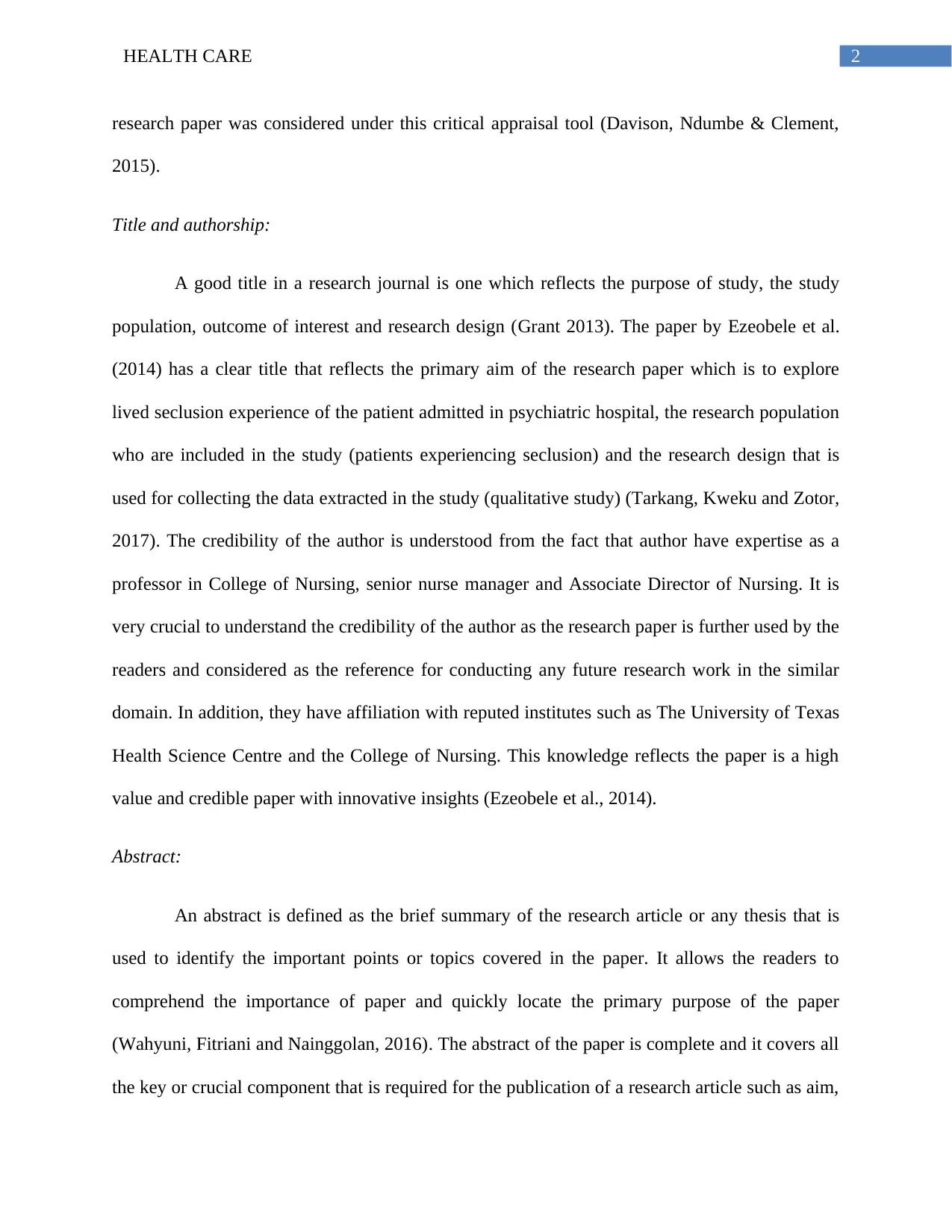
2HEALTH CARE
research paper was considered under this critical appraisal tool (Davison, Ndumbe & Clement,
2015).
Title and authorship:
A good title in a research journal is one which reflects the purpose of study, the study
population, outcome of interest and research design (Grant 2013). The paper by Ezeobele et al.
(2014) has a clear title that reflects the primary aim of the research paper which is to explore
lived seclusion experience of the patient admitted in psychiatric hospital, the research population
who are included in the study (patients experiencing seclusion) and the research design that is
used for collecting the data extracted in the study (qualitative study) (Tarkang, Kweku and Zotor,
2017). The credibility of the author is understood from the fact that author have expertise as a
professor in College of Nursing, senior nurse manager and Associate Director of Nursing. It is
very crucial to understand the credibility of the author as the research paper is further used by the
readers and considered as the reference for conducting any future research work in the similar
domain. In addition, they have affiliation with reputed institutes such as The University of Texas
Health Science Centre and the College of Nursing. This knowledge reflects the paper is a high
value and credible paper with innovative insights (Ezeobele et al., 2014).
Abstract:
An abstract is defined as the brief summary of the research article or any thesis that is
used to identify the important points or topics covered in the paper. It allows the readers to
comprehend the importance of paper and quickly locate the primary purpose of the paper
(Wahyuni, Fitriani and Nainggolan, 2016). The abstract of the paper is complete and it covers all
the key or crucial component that is required for the publication of a research article such as aim,
research paper was considered under this critical appraisal tool (Davison, Ndumbe & Clement,
2015).
Title and authorship:
A good title in a research journal is one which reflects the purpose of study, the study
population, outcome of interest and research design (Grant 2013). The paper by Ezeobele et al.
(2014) has a clear title that reflects the primary aim of the research paper which is to explore
lived seclusion experience of the patient admitted in psychiatric hospital, the research population
who are included in the study (patients experiencing seclusion) and the research design that is
used for collecting the data extracted in the study (qualitative study) (Tarkang, Kweku and Zotor,
2017). The credibility of the author is understood from the fact that author have expertise as a
professor in College of Nursing, senior nurse manager and Associate Director of Nursing. It is
very crucial to understand the credibility of the author as the research paper is further used by the
readers and considered as the reference for conducting any future research work in the similar
domain. In addition, they have affiliation with reputed institutes such as The University of Texas
Health Science Centre and the College of Nursing. This knowledge reflects the paper is a high
value and credible paper with innovative insights (Ezeobele et al., 2014).
Abstract:
An abstract is defined as the brief summary of the research article or any thesis that is
used to identify the important points or topics covered in the paper. It allows the readers to
comprehend the importance of paper and quickly locate the primary purpose of the paper
(Wahyuni, Fitriani and Nainggolan, 2016). The abstract of the paper is complete and it covers all
the key or crucial component that is required for the publication of a research article such as aim,
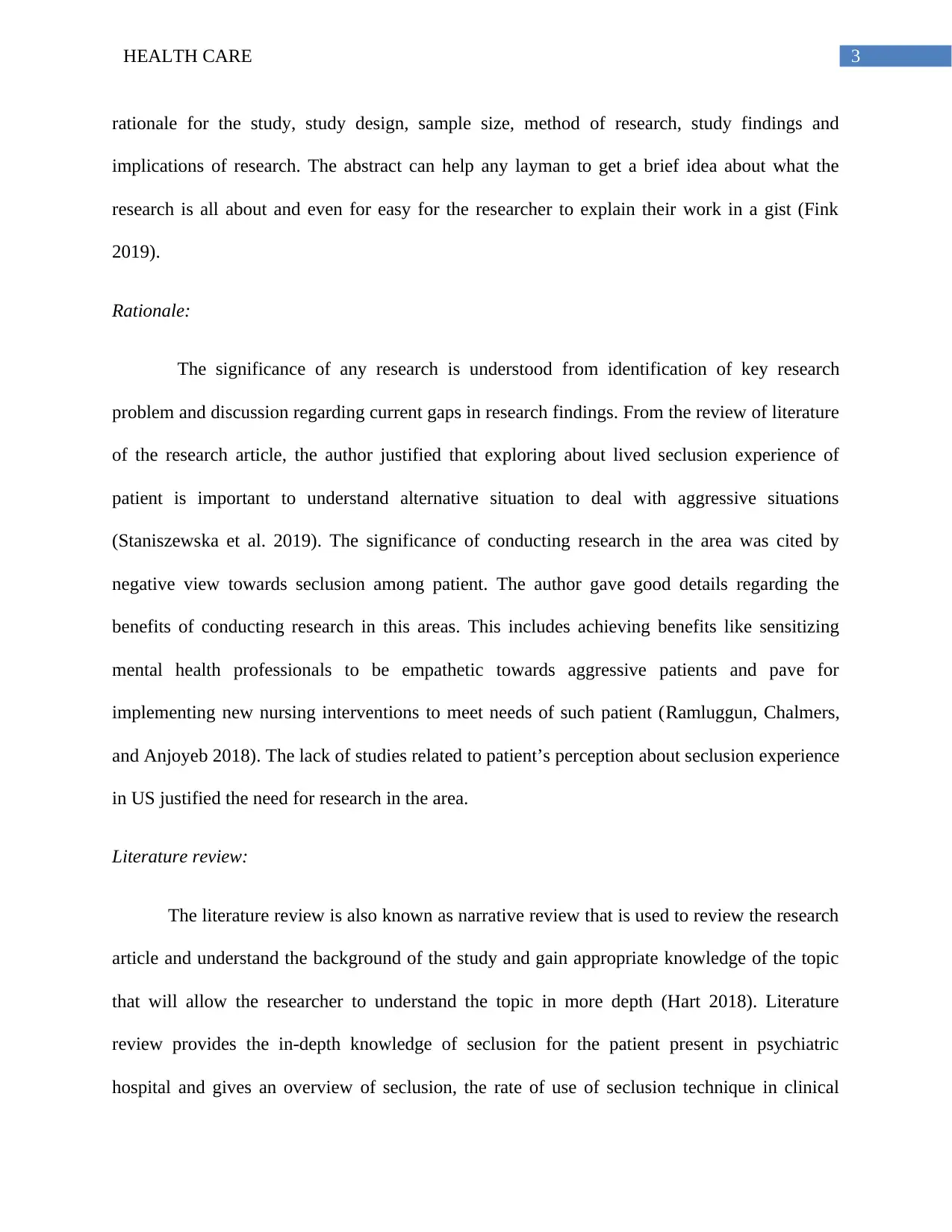
3HEALTH CARE
rationale for the study, study design, sample size, method of research, study findings and
implications of research. The abstract can help any layman to get a brief idea about what the
research is all about and even for easy for the researcher to explain their work in a gist (Fink
2019).
Rationale:
The significance of any research is understood from identification of key research
problem and discussion regarding current gaps in research findings. From the review of literature
of the research article, the author justified that exploring about lived seclusion experience of
patient is important to understand alternative situation to deal with aggressive situations
(Staniszewska et al. 2019). The significance of conducting research in the area was cited by
negative view towards seclusion among patient. The author gave good details regarding the
benefits of conducting research in this areas. This includes achieving benefits like sensitizing
mental health professionals to be empathetic towards aggressive patients and pave for
implementing new nursing interventions to meet needs of such patient (Ramluggun, Chalmers,
and Anjoyeb 2018). The lack of studies related to patient’s perception about seclusion experience
in US justified the need for research in the area.
Literature review:
The literature review is also known as narrative review that is used to review the research
article and understand the background of the study and gain appropriate knowledge of the topic
that will allow the researcher to understand the topic in more depth (Hart 2018). Literature
review provides the in-depth knowledge of seclusion for the patient present in psychiatric
hospital and gives an overview of seclusion, the rate of use of seclusion technique in clinical
rationale for the study, study design, sample size, method of research, study findings and
implications of research. The abstract can help any layman to get a brief idea about what the
research is all about and even for easy for the researcher to explain their work in a gist (Fink
2019).
Rationale:
The significance of any research is understood from identification of key research
problem and discussion regarding current gaps in research findings. From the review of literature
of the research article, the author justified that exploring about lived seclusion experience of
patient is important to understand alternative situation to deal with aggressive situations
(Staniszewska et al. 2019). The significance of conducting research in the area was cited by
negative view towards seclusion among patient. The author gave good details regarding the
benefits of conducting research in this areas. This includes achieving benefits like sensitizing
mental health professionals to be empathetic towards aggressive patients and pave for
implementing new nursing interventions to meet needs of such patient (Ramluggun, Chalmers,
and Anjoyeb 2018). The lack of studies related to patient’s perception about seclusion experience
in US justified the need for research in the area.
Literature review:
The literature review is also known as narrative review that is used to review the research
article and understand the background of the study and gain appropriate knowledge of the topic
that will allow the researcher to understand the topic in more depth (Hart 2018). Literature
review provides the in-depth knowledge of seclusion for the patient present in psychiatric
hospital and gives an overview of seclusion, the rate of use of seclusion technique in clinical
Secure Best Marks with AI Grader
Need help grading? Try our AI Grader for instant feedback on your assignments.
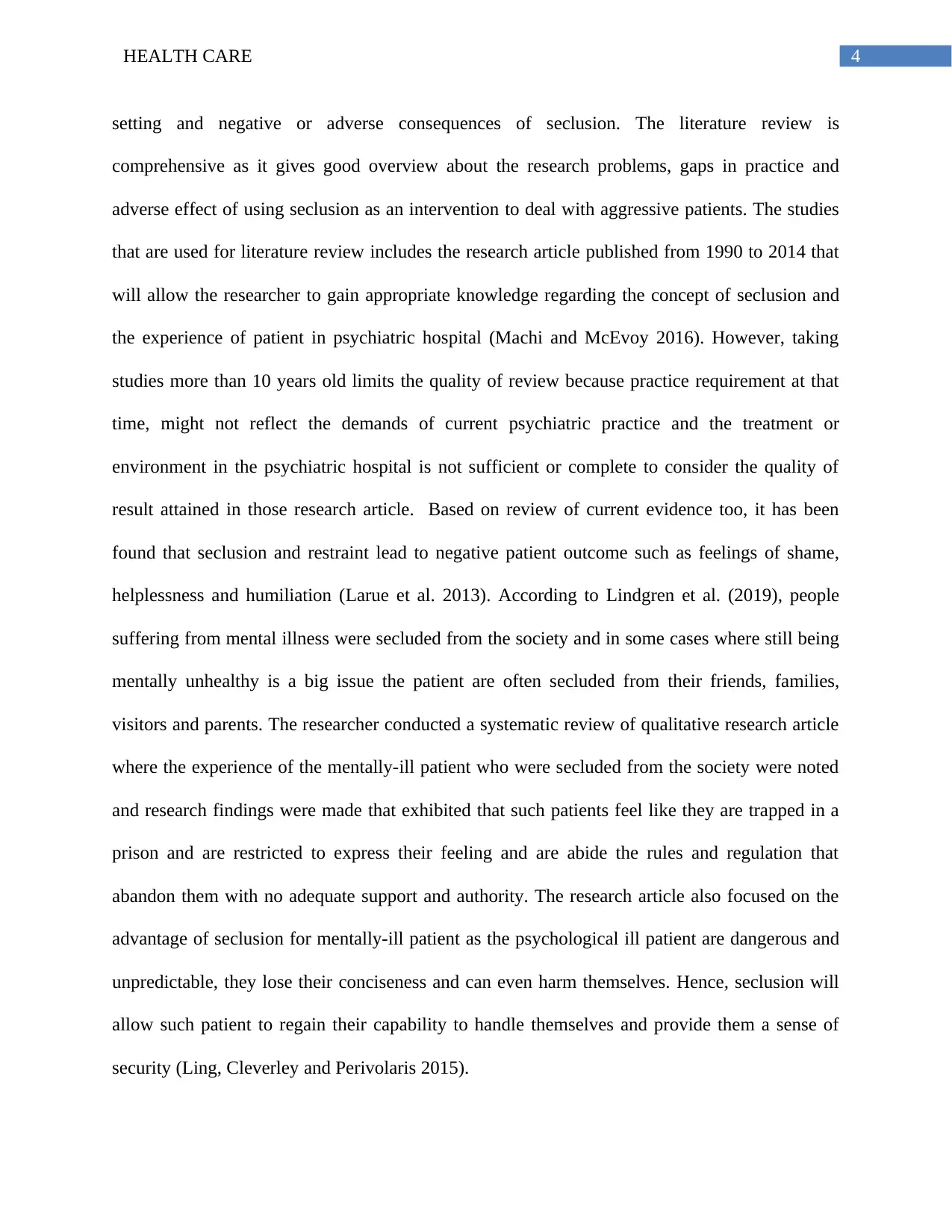
4HEALTH CARE
setting and negative or adverse consequences of seclusion. The literature review is
comprehensive as it gives good overview about the research problems, gaps in practice and
adverse effect of using seclusion as an intervention to deal with aggressive patients. The studies
that are used for literature review includes the research article published from 1990 to 2014 that
will allow the researcher to gain appropriate knowledge regarding the concept of seclusion and
the experience of patient in psychiatric hospital (Machi and McEvoy 2016). However, taking
studies more than 10 years old limits the quality of review because practice requirement at that
time, might not reflect the demands of current psychiatric practice and the treatment or
environment in the psychiatric hospital is not sufficient or complete to consider the quality of
result attained in those research article. Based on review of current evidence too, it has been
found that seclusion and restraint lead to negative patient outcome such as feelings of shame,
helplessness and humiliation (Larue et al. 2013). According to Lindgren et al. (2019), people
suffering from mental illness were secluded from the society and in some cases where still being
mentally unhealthy is a big issue the patient are often secluded from their friends, families,
visitors and parents. The researcher conducted a systematic review of qualitative research article
where the experience of the mentally-ill patient who were secluded from the society were noted
and research findings were made that exhibited that such patients feel like they are trapped in a
prison and are restricted to express their feeling and are abide the rules and regulation that
abandon them with no adequate support and authority. The research article also focused on the
advantage of seclusion for mentally-ill patient as the psychological ill patient are dangerous and
unpredictable, they lose their conciseness and can even harm themselves. Hence, seclusion will
allow such patient to regain their capability to handle themselves and provide them a sense of
security (Ling, Cleverley and Perivolaris 2015).
setting and negative or adverse consequences of seclusion. The literature review is
comprehensive as it gives good overview about the research problems, gaps in practice and
adverse effect of using seclusion as an intervention to deal with aggressive patients. The studies
that are used for literature review includes the research article published from 1990 to 2014 that
will allow the researcher to gain appropriate knowledge regarding the concept of seclusion and
the experience of patient in psychiatric hospital (Machi and McEvoy 2016). However, taking
studies more than 10 years old limits the quality of review because practice requirement at that
time, might not reflect the demands of current psychiatric practice and the treatment or
environment in the psychiatric hospital is not sufficient or complete to consider the quality of
result attained in those research article. Based on review of current evidence too, it has been
found that seclusion and restraint lead to negative patient outcome such as feelings of shame,
helplessness and humiliation (Larue et al. 2013). According to Lindgren et al. (2019), people
suffering from mental illness were secluded from the society and in some cases where still being
mentally unhealthy is a big issue the patient are often secluded from their friends, families,
visitors and parents. The researcher conducted a systematic review of qualitative research article
where the experience of the mentally-ill patient who were secluded from the society were noted
and research findings were made that exhibited that such patients feel like they are trapped in a
prison and are restricted to express their feeling and are abide the rules and regulation that
abandon them with no adequate support and authority. The research article also focused on the
advantage of seclusion for mentally-ill patient as the psychological ill patient are dangerous and
unpredictable, they lose their conciseness and can even harm themselves. Hence, seclusion will
allow such patient to regain their capability to handle themselves and provide them a sense of
security (Ling, Cleverley and Perivolaris 2015).
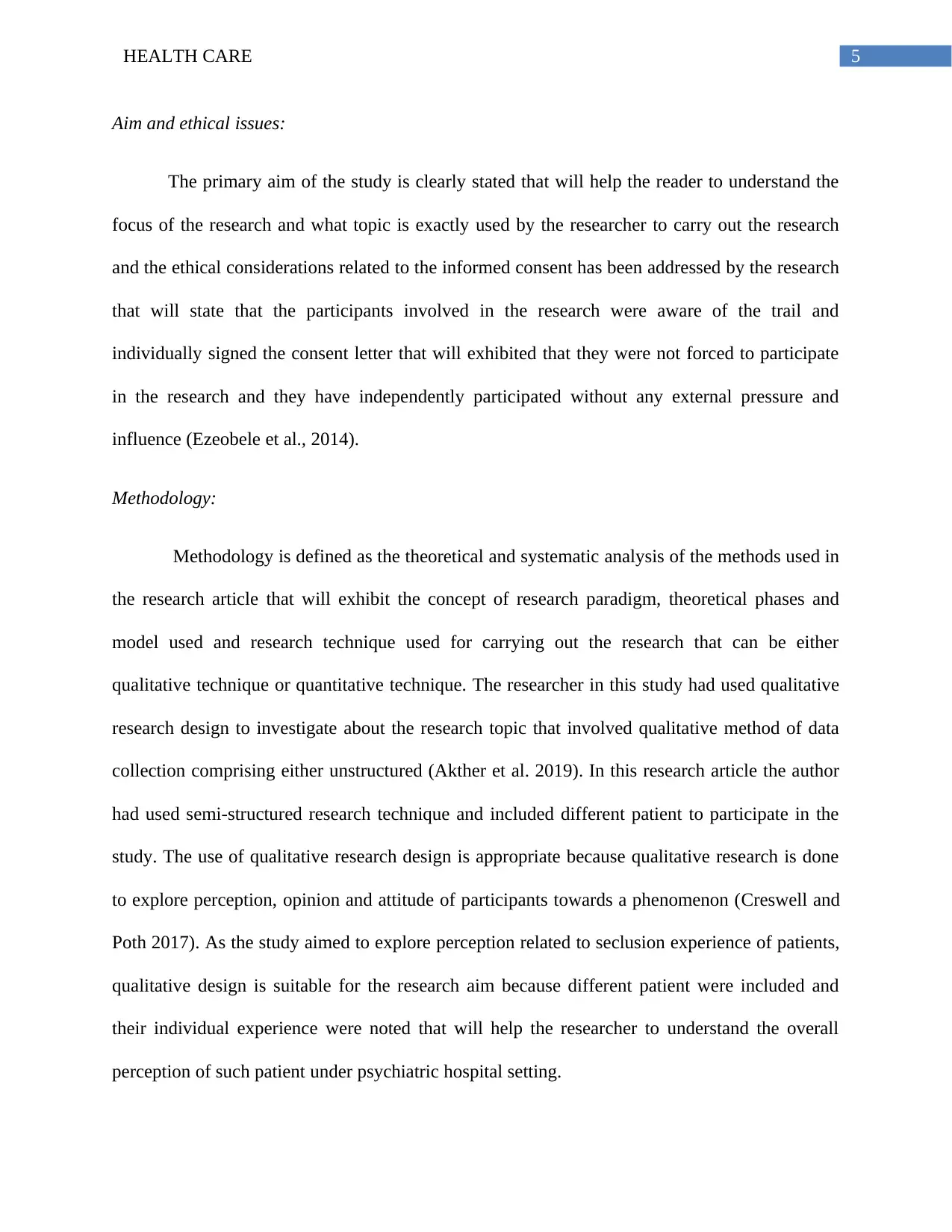
5HEALTH CARE
Aim and ethical issues:
The primary aim of the study is clearly stated that will help the reader to understand the
focus of the research and what topic is exactly used by the researcher to carry out the research
and the ethical considerations related to the informed consent has been addressed by the research
that will state that the participants involved in the research were aware of the trail and
individually signed the consent letter that will exhibited that they were not forced to participate
in the research and they have independently participated without any external pressure and
influence (Ezeobele et al., 2014).
Methodology:
Methodology is defined as the theoretical and systematic analysis of the methods used in
the research article that will exhibit the concept of research paradigm, theoretical phases and
model used and research technique used for carrying out the research that can be either
qualitative technique or quantitative technique. The researcher in this study had used qualitative
research design to investigate about the research topic that involved qualitative method of data
collection comprising either unstructured (Akther et al. 2019). In this research article the author
had used semi-structured research technique and included different patient to participate in the
study. The use of qualitative research design is appropriate because qualitative research is done
to explore perception, opinion and attitude of participants towards a phenomenon (Creswell and
Poth 2017). As the study aimed to explore perception related to seclusion experience of patients,
qualitative design is suitable for the research aim because different patient were included and
their individual experience were noted that will help the researcher to understand the overall
perception of such patient under psychiatric hospital setting.
Aim and ethical issues:
The primary aim of the study is clearly stated that will help the reader to understand the
focus of the research and what topic is exactly used by the researcher to carry out the research
and the ethical considerations related to the informed consent has been addressed by the research
that will state that the participants involved in the research were aware of the trail and
individually signed the consent letter that will exhibited that they were not forced to participate
in the research and they have independently participated without any external pressure and
influence (Ezeobele et al., 2014).
Methodology:
Methodology is defined as the theoretical and systematic analysis of the methods used in
the research article that will exhibit the concept of research paradigm, theoretical phases and
model used and research technique used for carrying out the research that can be either
qualitative technique or quantitative technique. The researcher in this study had used qualitative
research design to investigate about the research topic that involved qualitative method of data
collection comprising either unstructured (Akther et al. 2019). In this research article the author
had used semi-structured research technique and included different patient to participate in the
study. The use of qualitative research design is appropriate because qualitative research is done
to explore perception, opinion and attitude of participants towards a phenomenon (Creswell and
Poth 2017). As the study aimed to explore perception related to seclusion experience of patients,
qualitative design is suitable for the research aim because different patient were included and
their individual experience were noted that will help the researcher to understand the overall
perception of such patient under psychiatric hospital setting.
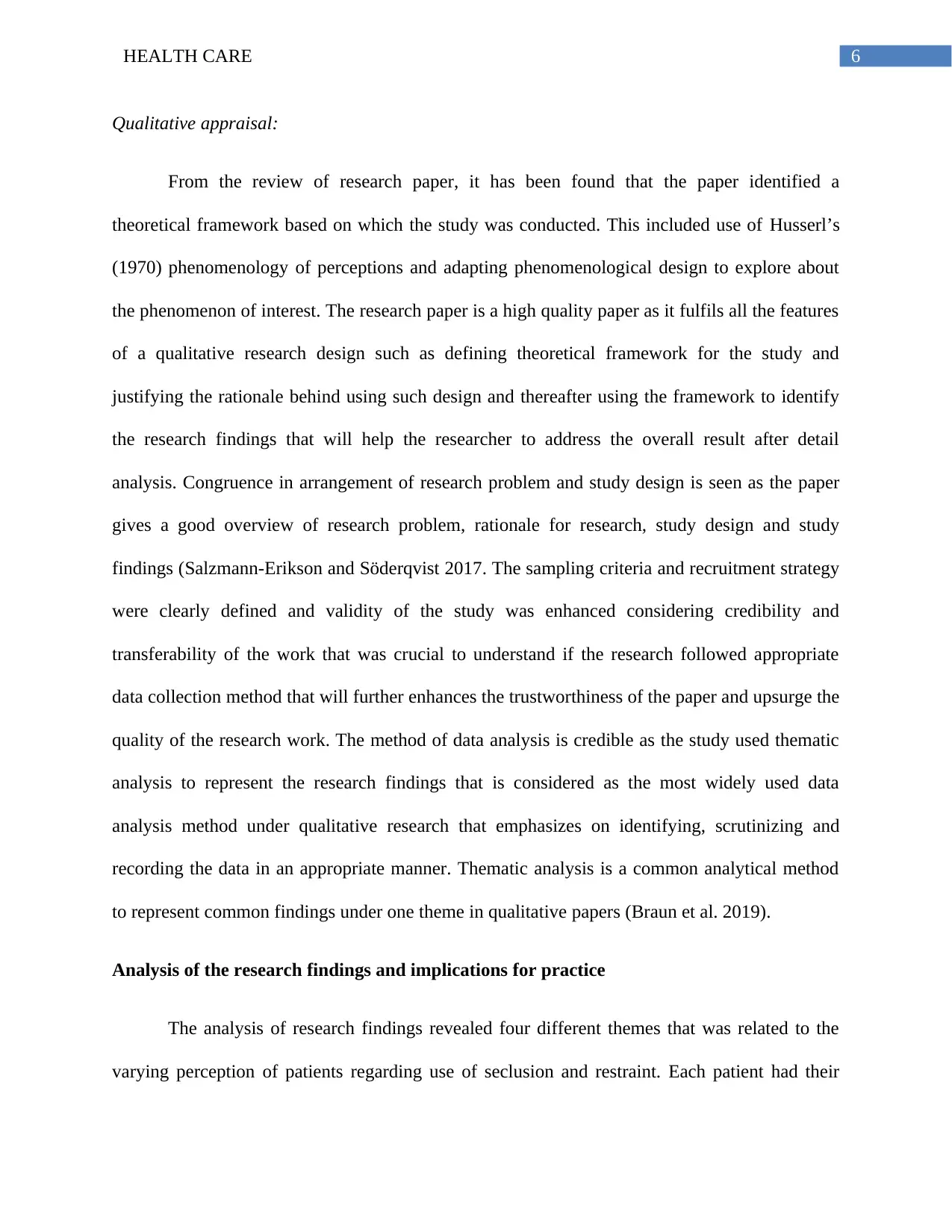
6HEALTH CARE
Qualitative appraisal:
From the review of research paper, it has been found that the paper identified a
theoretical framework based on which the study was conducted. This included use of Husserl’s
(1970) phenomenology of perceptions and adapting phenomenological design to explore about
the phenomenon of interest. The research paper is a high quality paper as it fulfils all the features
of a qualitative research design such as defining theoretical framework for the study and
justifying the rationale behind using such design and thereafter using the framework to identify
the research findings that will help the researcher to address the overall result after detail
analysis. Congruence in arrangement of research problem and study design is seen as the paper
gives a good overview of research problem, rationale for research, study design and study
findings (Salzmann-Erikson and Söderqvist 2017. The sampling criteria and recruitment strategy
were clearly defined and validity of the study was enhanced considering credibility and
transferability of the work that was crucial to understand if the research followed appropriate
data collection method that will further enhances the trustworthiness of the paper and upsurge the
quality of the research work. The method of data analysis is credible as the study used thematic
analysis to represent the research findings that is considered as the most widely used data
analysis method under qualitative research that emphasizes on identifying, scrutinizing and
recording the data in an appropriate manner. Thematic analysis is a common analytical method
to represent common findings under one theme in qualitative papers (Braun et al. 2019).
Analysis of the research findings and implications for practice
The analysis of research findings revealed four different themes that was related to the
varying perception of patients regarding use of seclusion and restraint. Each patient had their
Qualitative appraisal:
From the review of research paper, it has been found that the paper identified a
theoretical framework based on which the study was conducted. This included use of Husserl’s
(1970) phenomenology of perceptions and adapting phenomenological design to explore about
the phenomenon of interest. The research paper is a high quality paper as it fulfils all the features
of a qualitative research design such as defining theoretical framework for the study and
justifying the rationale behind using such design and thereafter using the framework to identify
the research findings that will help the researcher to address the overall result after detail
analysis. Congruence in arrangement of research problem and study design is seen as the paper
gives a good overview of research problem, rationale for research, study design and study
findings (Salzmann-Erikson and Söderqvist 2017. The sampling criteria and recruitment strategy
were clearly defined and validity of the study was enhanced considering credibility and
transferability of the work that was crucial to understand if the research followed appropriate
data collection method that will further enhances the trustworthiness of the paper and upsurge the
quality of the research work. The method of data analysis is credible as the study used thematic
analysis to represent the research findings that is considered as the most widely used data
analysis method under qualitative research that emphasizes on identifying, scrutinizing and
recording the data in an appropriate manner. Thematic analysis is a common analytical method
to represent common findings under one theme in qualitative papers (Braun et al. 2019).
Analysis of the research findings and implications for practice
The analysis of research findings revealed four different themes that was related to the
varying perception of patients regarding use of seclusion and restraint. Each patient had their
Paraphrase This Document
Need a fresh take? Get an instant paraphrase of this document with our AI Paraphraser
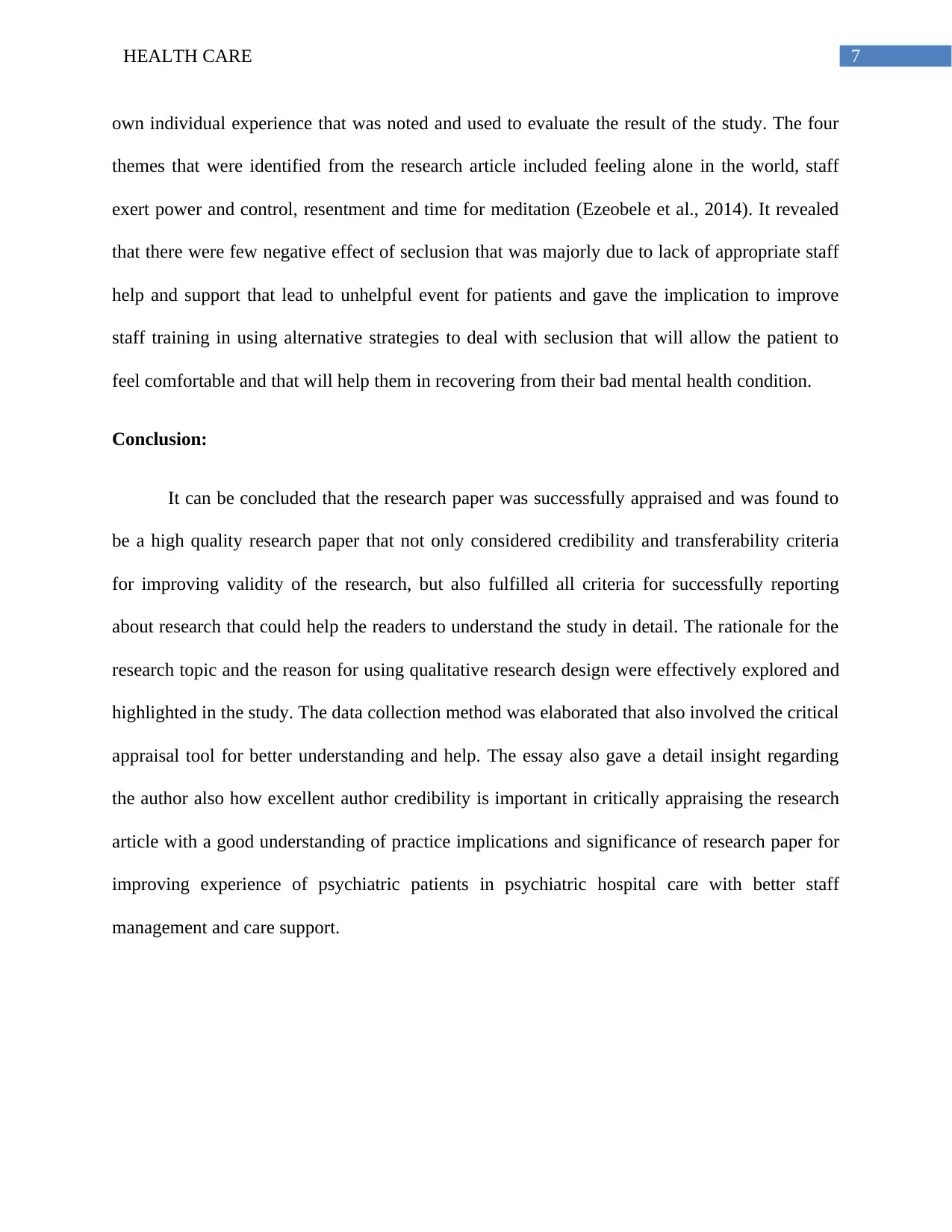
7HEALTH CARE
own individual experience that was noted and used to evaluate the result of the study. The four
themes that were identified from the research article included feeling alone in the world, staff
exert power and control, resentment and time for meditation (Ezeobele et al., 2014). It revealed
that there were few negative effect of seclusion that was majorly due to lack of appropriate staff
help and support that lead to unhelpful event for patients and gave the implication to improve
staff training in using alternative strategies to deal with seclusion that will allow the patient to
feel comfortable and that will help them in recovering from their bad mental health condition.
Conclusion:
It can be concluded that the research paper was successfully appraised and was found to
be a high quality research paper that not only considered credibility and transferability criteria
for improving validity of the research, but also fulfilled all criteria for successfully reporting
about research that could help the readers to understand the study in detail. The rationale for the
research topic and the reason for using qualitative research design were effectively explored and
highlighted in the study. The data collection method was elaborated that also involved the critical
appraisal tool for better understanding and help. The essay also gave a detail insight regarding
the author also how excellent author credibility is important in critically appraising the research
article with a good understanding of practice implications and significance of research paper for
improving experience of psychiatric patients in psychiatric hospital care with better staff
management and care support.
own individual experience that was noted and used to evaluate the result of the study. The four
themes that were identified from the research article included feeling alone in the world, staff
exert power and control, resentment and time for meditation (Ezeobele et al., 2014). It revealed
that there were few negative effect of seclusion that was majorly due to lack of appropriate staff
help and support that lead to unhelpful event for patients and gave the implication to improve
staff training in using alternative strategies to deal with seclusion that will allow the patient to
feel comfortable and that will help them in recovering from their bad mental health condition.
Conclusion:
It can be concluded that the research paper was successfully appraised and was found to
be a high quality research paper that not only considered credibility and transferability criteria
for improving validity of the research, but also fulfilled all criteria for successfully reporting
about research that could help the readers to understand the study in detail. The rationale for the
research topic and the reason for using qualitative research design were effectively explored and
highlighted in the study. The data collection method was elaborated that also involved the critical
appraisal tool for better understanding and help. The essay also gave a detail insight regarding
the author also how excellent author credibility is important in critically appraising the research
article with a good understanding of practice implications and significance of research paper for
improving experience of psychiatric patients in psychiatric hospital care with better staff
management and care support.
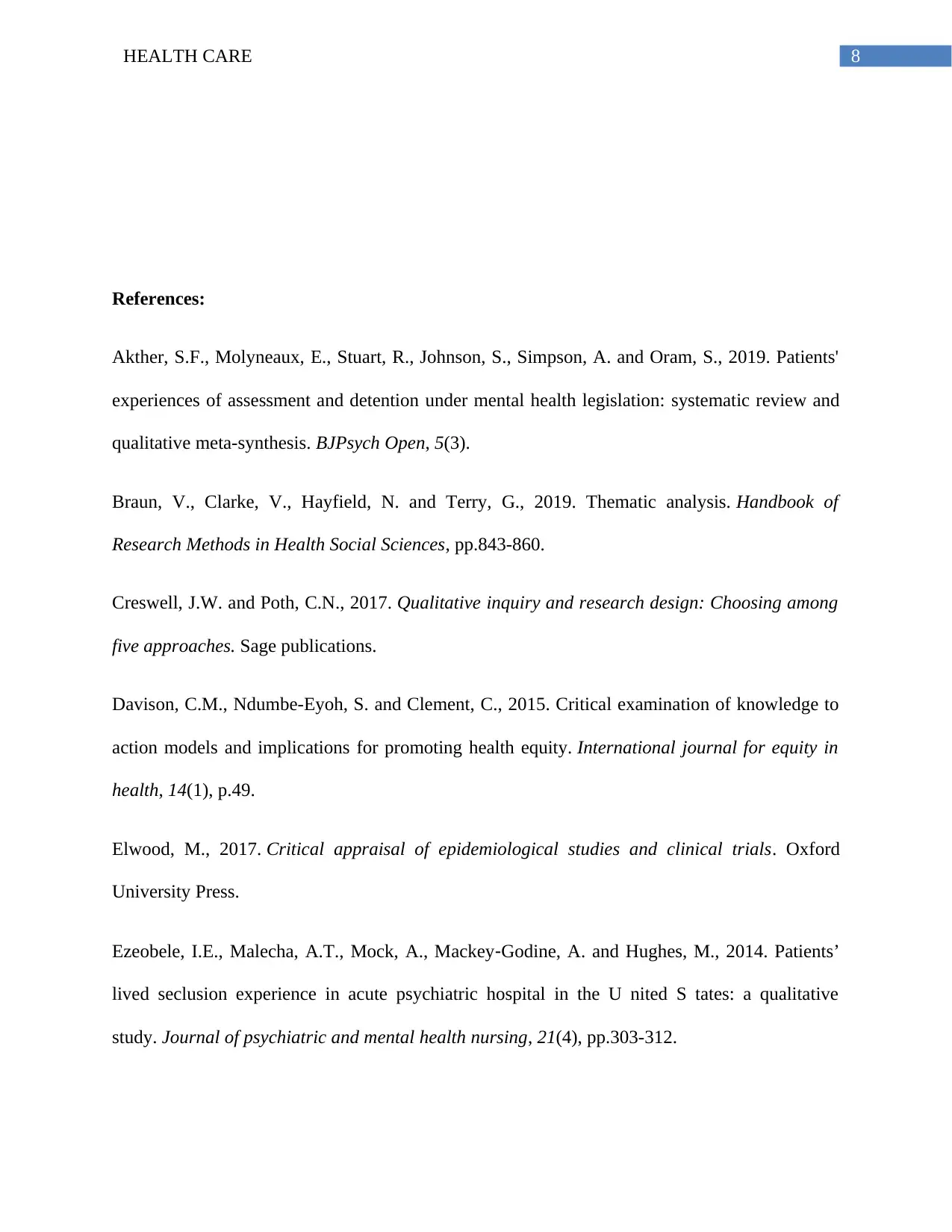
8HEALTH CARE
References:
Akther, S.F., Molyneaux, E., Stuart, R., Johnson, S., Simpson, A. and Oram, S., 2019. Patients'
experiences of assessment and detention under mental health legislation: systematic review and
qualitative meta-synthesis. BJPsych Open, 5(3).
Braun, V., Clarke, V., Hayfield, N. and Terry, G., 2019. Thematic analysis. Handbook of
Research Methods in Health Social Sciences, pp.843-860.
Creswell, J.W. and Poth, C.N., 2017. Qualitative inquiry and research design: Choosing among
five approaches. Sage publications.
Davison, C.M., Ndumbe-Eyoh, S. and Clement, C., 2015. Critical examination of knowledge to
action models and implications for promoting health equity. International journal for equity in
health, 14(1), p.49.
Elwood, M., 2017. Critical appraisal of epidemiological studies and clinical trials. Oxford
University Press.
Ezeobele, I.E., Malecha, A.T., Mock, A., Mackey‐Godine, A. and Hughes, M., 2014. Patients’
lived seclusion experience in acute psychiatric hospital in the U nited S tates: a qualitative
study. Journal of psychiatric and mental health nursing, 21(4), pp.303-312.
References:
Akther, S.F., Molyneaux, E., Stuart, R., Johnson, S., Simpson, A. and Oram, S., 2019. Patients'
experiences of assessment and detention under mental health legislation: systematic review and
qualitative meta-synthesis. BJPsych Open, 5(3).
Braun, V., Clarke, V., Hayfield, N. and Terry, G., 2019. Thematic analysis. Handbook of
Research Methods in Health Social Sciences, pp.843-860.
Creswell, J.W. and Poth, C.N., 2017. Qualitative inquiry and research design: Choosing among
five approaches. Sage publications.
Davison, C.M., Ndumbe-Eyoh, S. and Clement, C., 2015. Critical examination of knowledge to
action models and implications for promoting health equity. International journal for equity in
health, 14(1), p.49.
Elwood, M., 2017. Critical appraisal of epidemiological studies and clinical trials. Oxford
University Press.
Ezeobele, I.E., Malecha, A.T., Mock, A., Mackey‐Godine, A. and Hughes, M., 2014. Patients’
lived seclusion experience in acute psychiatric hospital in the U nited S tates: a qualitative
study. Journal of psychiatric and mental health nursing, 21(4), pp.303-312.
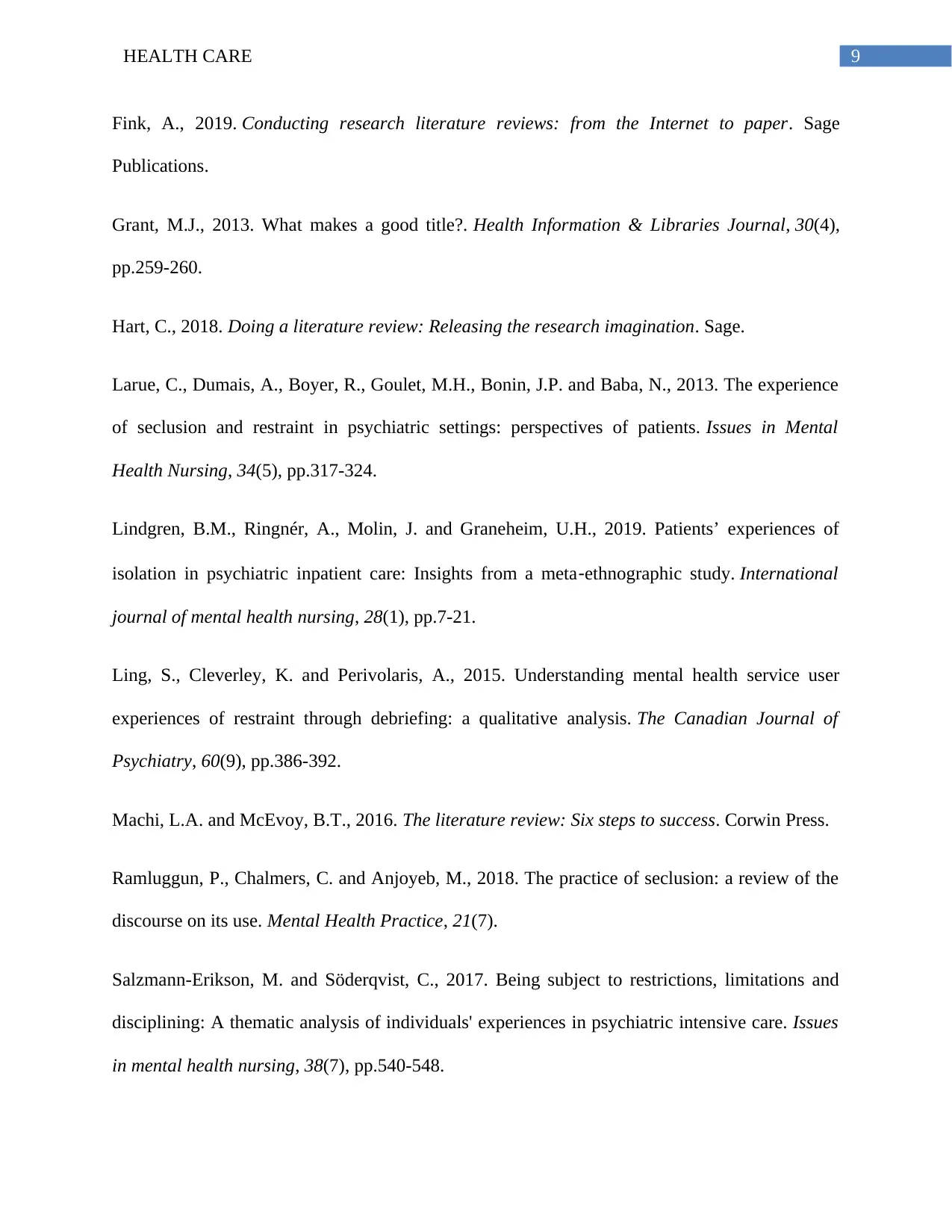
9HEALTH CARE
Fink, A., 2019. Conducting research literature reviews: from the Internet to paper. Sage
Publications.
Grant, M.J., 2013. What makes a good title?. Health Information & Libraries Journal, 30(4),
pp.259-260.
Hart, C., 2018. Doing a literature review: Releasing the research imagination. Sage.
Larue, C., Dumais, A., Boyer, R., Goulet, M.H., Bonin, J.P. and Baba, N., 2013. The experience
of seclusion and restraint in psychiatric settings: perspectives of patients. Issues in Mental
Health Nursing, 34(5), pp.317-324.
Lindgren, B.M., Ringnér, A., Molin, J. and Graneheim, U.H., 2019. Patients’ experiences of
isolation in psychiatric inpatient care: Insights from a meta‐ethnographic study. International
journal of mental health nursing, 28(1), pp.7-21.
Ling, S., Cleverley, K. and Perivolaris, A., 2015. Understanding mental health service user
experiences of restraint through debriefing: a qualitative analysis. The Canadian Journal of
Psychiatry, 60(9), pp.386-392.
Machi, L.A. and McEvoy, B.T., 2016. The literature review: Six steps to success. Corwin Press.
Ramluggun, P., Chalmers, C. and Anjoyeb, M., 2018. The practice of seclusion: a review of the
discourse on its use. Mental Health Practice, 21(7).
Salzmann-Erikson, M. and Söderqvist, C., 2017. Being subject to restrictions, limitations and
disciplining: A thematic analysis of individuals' experiences in psychiatric intensive care. Issues
in mental health nursing, 38(7), pp.540-548.
Fink, A., 2019. Conducting research literature reviews: from the Internet to paper. Sage
Publications.
Grant, M.J., 2013. What makes a good title?. Health Information & Libraries Journal, 30(4),
pp.259-260.
Hart, C., 2018. Doing a literature review: Releasing the research imagination. Sage.
Larue, C., Dumais, A., Boyer, R., Goulet, M.H., Bonin, J.P. and Baba, N., 2013. The experience
of seclusion and restraint in psychiatric settings: perspectives of patients. Issues in Mental
Health Nursing, 34(5), pp.317-324.
Lindgren, B.M., Ringnér, A., Molin, J. and Graneheim, U.H., 2019. Patients’ experiences of
isolation in psychiatric inpatient care: Insights from a meta‐ethnographic study. International
journal of mental health nursing, 28(1), pp.7-21.
Ling, S., Cleverley, K. and Perivolaris, A., 2015. Understanding mental health service user
experiences of restraint through debriefing: a qualitative analysis. The Canadian Journal of
Psychiatry, 60(9), pp.386-392.
Machi, L.A. and McEvoy, B.T., 2016. The literature review: Six steps to success. Corwin Press.
Ramluggun, P., Chalmers, C. and Anjoyeb, M., 2018. The practice of seclusion: a review of the
discourse on its use. Mental Health Practice, 21(7).
Salzmann-Erikson, M. and Söderqvist, C., 2017. Being subject to restrictions, limitations and
disciplining: A thematic analysis of individuals' experiences in psychiatric intensive care. Issues
in mental health nursing, 38(7), pp.540-548.
Secure Best Marks with AI Grader
Need help grading? Try our AI Grader for instant feedback on your assignments.
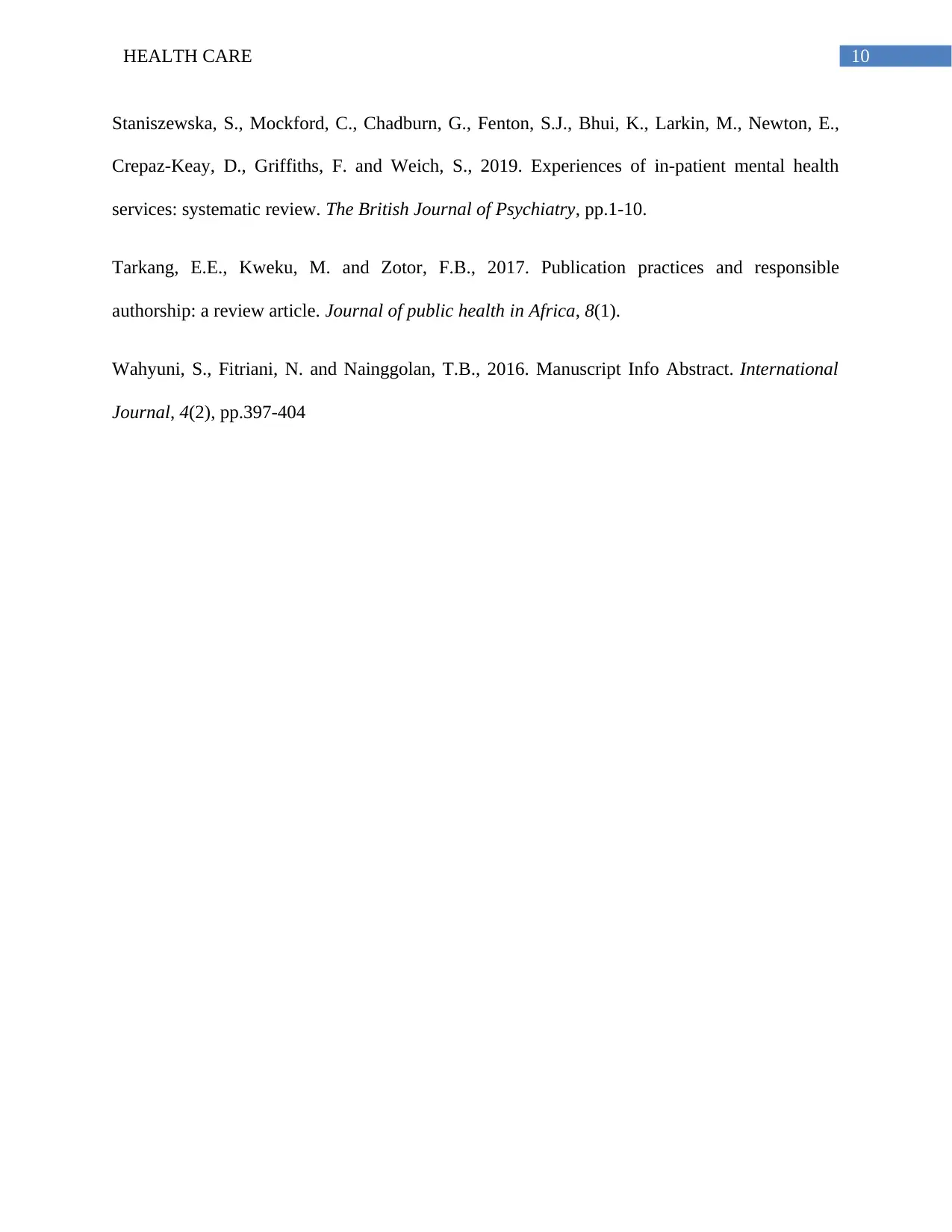
10HEALTH CARE
Staniszewska, S., Mockford, C., Chadburn, G., Fenton, S.J., Bhui, K., Larkin, M., Newton, E.,
Crepaz-Keay, D., Griffiths, F. and Weich, S., 2019. Experiences of in-patient mental health
services: systematic review. The British Journal of Psychiatry, pp.1-10.
Tarkang, E.E., Kweku, M. and Zotor, F.B., 2017. Publication practices and responsible
authorship: a review article. Journal of public health in Africa, 8(1).
Wahyuni, S., Fitriani, N. and Nainggolan, T.B., 2016. Manuscript Info Abstract. International
Journal, 4(2), pp.397-404
Staniszewska, S., Mockford, C., Chadburn, G., Fenton, S.J., Bhui, K., Larkin, M., Newton, E.,
Crepaz-Keay, D., Griffiths, F. and Weich, S., 2019. Experiences of in-patient mental health
services: systematic review. The British Journal of Psychiatry, pp.1-10.
Tarkang, E.E., Kweku, M. and Zotor, F.B., 2017. Publication practices and responsible
authorship: a review article. Journal of public health in Africa, 8(1).
Wahyuni, S., Fitriani, N. and Nainggolan, T.B., 2016. Manuscript Info Abstract. International
Journal, 4(2), pp.397-404
1 out of 11
Related Documents
Your All-in-One AI-Powered Toolkit for Academic Success.
+13062052269
info@desklib.com
Available 24*7 on WhatsApp / Email
![[object Object]](/_next/static/media/star-bottom.7253800d.svg)
Unlock your academic potential
© 2024 | Zucol Services PVT LTD | All rights reserved.




